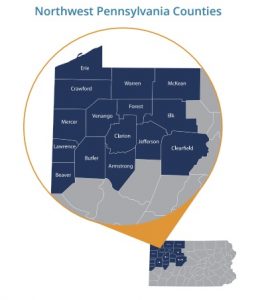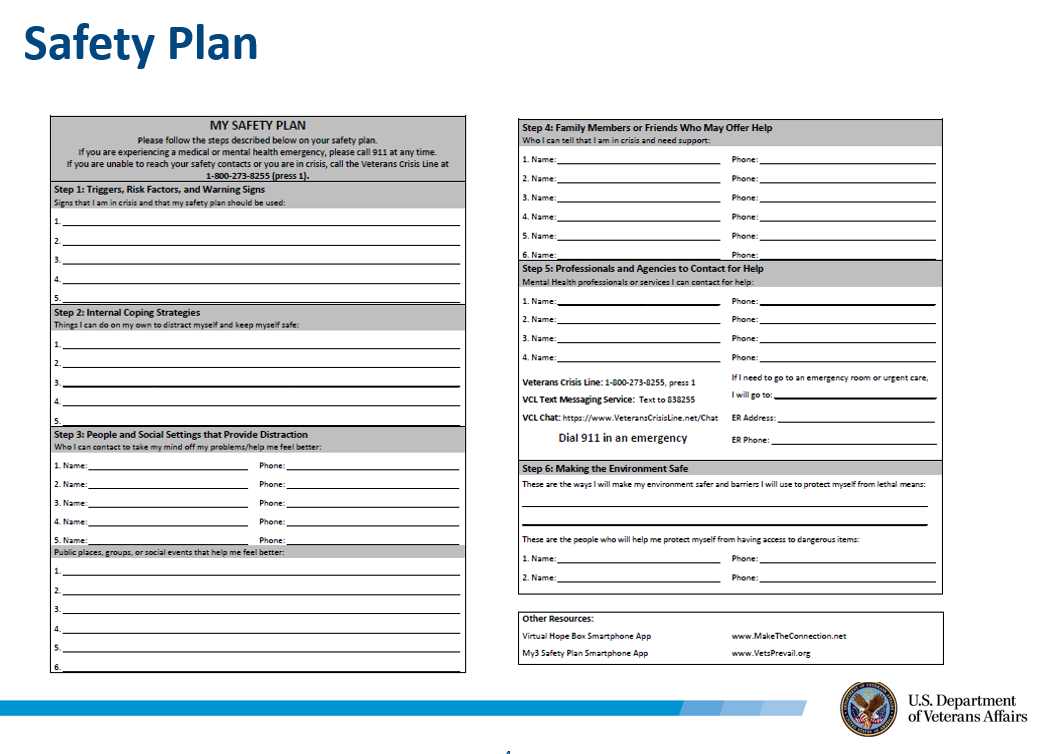Suicide Prevention Safety Planning

The Northwest Pennsylvania (NW PA) Veteran Suicide Prevention Program operates on a three-pronged approach involving healthcare providers, community organizations, and Veterans and their families in the 15 counties of NW PA.
This article summarizes a recent research presentation by Pete Albert, MSN, RN and SP Program Manager, VISN 4, U.S. Department of Veterans Affairs and explores the following topics:
- What is a safety plan?
- How do you develop a safety plan?
- What are some tips for safety plan success?
Read time: 7 minutes
A pdf of the full presentation, including sources and resources, is available for download.
What is a safety plan?
A safety plan is a list of prioritized coping strategies and resources that people at risk for suicide can use in times of emotional distress or during a crisis. Safety plans are brief and written from the patient’s perspective. Shown below is an image of the Stanley-Brown Safety Plan. Please view the pdf of the full presentation to see the plan in greater detail.
How do we develop a safety plan?
 A safety plan should include six steps for ensuring the patient’s safety:
A safety plan should include six steps for ensuring the patient’s safety:
- Recognize warning signs.
- Identify internal coping strategies.
- Identify people and social settings that can provide distraction.
- Family members and trusted friends who could offer support.
- Professionals and Agencies to contact for help.
- Making the environment safe.
Tips for safety plan success
 Emphasize the plan is not meant to eliminate stress, solve problems or “cure” conditions. It is a very specific plan for preventing crisis with the goal of managing acute stressors independently. If appropriate, discuss the individual’s relationship between substance use and suicidal ideation. This is an opportunity to reflect on the role alcohol/substances have played in previous suicidal thoughts or behaviors.
Emphasize the plan is not meant to eliminate stress, solve problems or “cure” conditions. It is a very specific plan for preventing crisis with the goal of managing acute stressors independently. If appropriate, discuss the individual’s relationship between substance use and suicidal ideation. This is an opportunity to reflect on the role alcohol/substances have played in previous suicidal thoughts or behaviors.
- Be specific with what is listed, use patient’s language
- Make it personal and relevant
- Make sure they have a copy!
- Keep copies in multiple places
- Share with someone you trust
- Update whenever a major change occurs, or 1-2 times per year
- Review the plan often
- Consider smart phone Apps: Virtual Hope Box, Safety plan App.
Share Our Vision and Get Involved
Our Vision: The work of the Northwest Pennsylvania Veteran Suicide Prevention Program will result in resident Veteran suicides being reduced to zero by the end of the project period (August 31, 2025).
Whether you identify as a healthcare provider, community organization, or Veteran, there are several opportunities through the NW PA Veteran Suicide Prevention Program and PERU to connect to resources, participate in educational training, and promote harm reduction strategies. We are actively recruiting healthcare and community partners to work with us in meeting our goals and objectives. To learn more, visit the program website at theresilientveteran.org.
Need Help? Know Someone Who Does? Contact the National Suicide Prevention Lifeline at 988 or use the online Lifeline Crisis Chat. Both are free and confidential. You’ll be connected to a skilled, trained counselor in your area.

